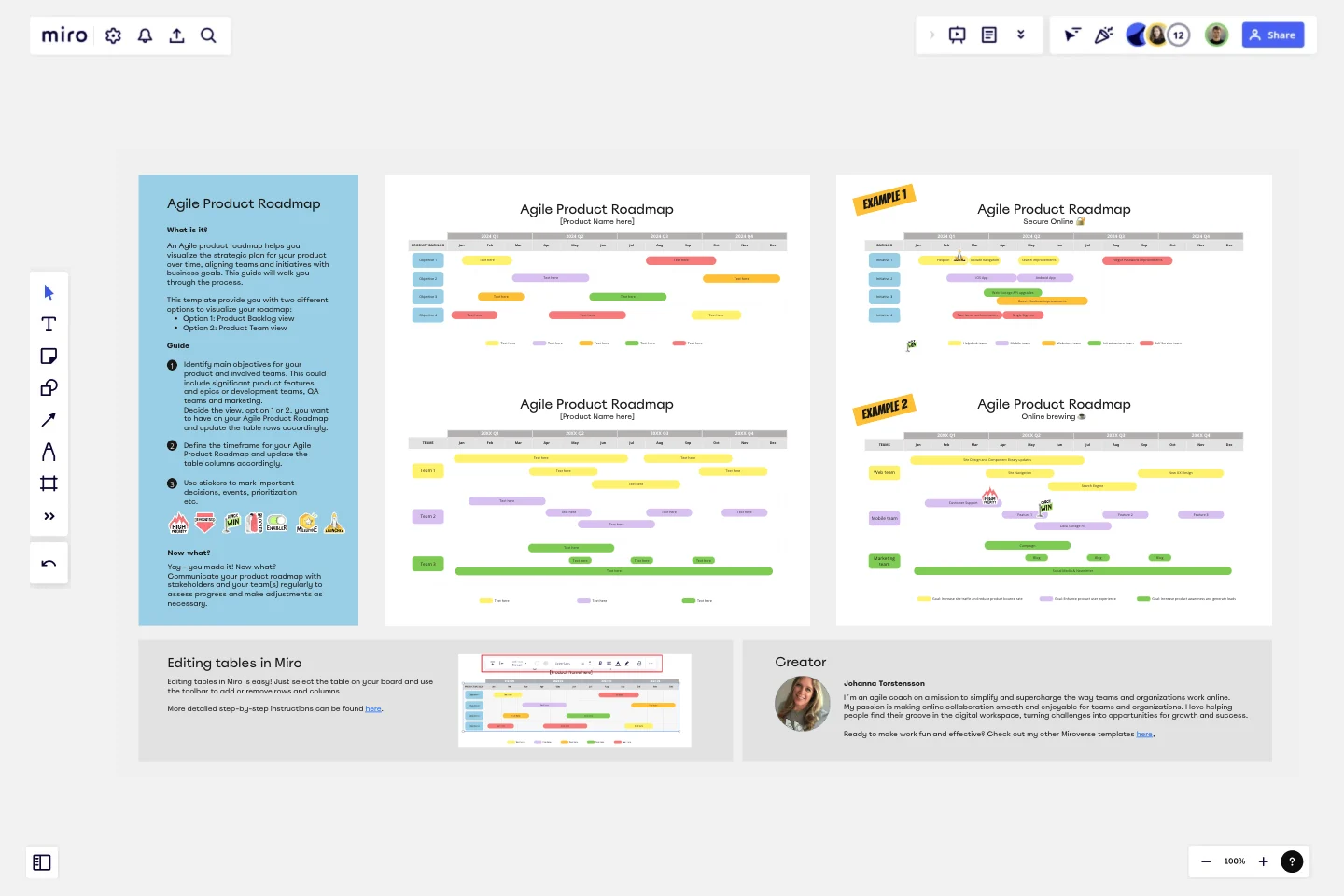Agile Product Roadmap 🚀
An Agile product roadmap helps you visualize the strategic plan for your product over time, aligning teams and initiatives with business goals.
What is it?
An Agile product roadmap helps you visualize the strategic plan for your product over time, aligning teams and initiatives with business goals. This template provide a guide to create your own Agile Product Roadmap with two different options to visualize your roadmap:
Option 1: Product Backlog view
Option 2: Product Team view
Who is it for?
An agile product roadmap is a strategic tool used by various roles within an organization to guide product development and deliveries:
Product Owner: Uses the roadmap to prioritize features, communicate vision, and align the team's work with business goals.
Scrum Master: Utilizes it to facilitate sprint planning, manage workloads, and ensure the team remains focused on delivering value.
Development Team: Refers to the roadmap to understand upcoming work and how their tasks contribute to overall goals.
Stakeholders (Executives, Marketing, Sales): Stay informed about product direction and upcoming releases to align their strategies.
UX/UI Designers: Plan user research and design sprints to align with upcoming features.
Project Managers: Track progress, manage risks, and ensure development stays on schedule.
How to use it?
There is a simple step-by-step guide in the template how to create you own Agile Product Roadmap. This will be a perfect tool to communicate your product´s vision for the upcoming period and to keep track on the deliveries.
Get started with this template right now.
Goals-based Roadmap
Works best for:
Roadmap, Planning, Mapping
The Goals-based Roadmap template enables teams to set clear objectives and chart a course for achieving them. By defining specific goals and milestones, teams can track progress and adapt their strategies accordingly. This template fosters accountability and transparency, ensuring that everyone is working towards common objectives. With a focus on outcomes, teams can prioritize initiatives that drive the greatest impact and value.
Recruitment Strategy Roadmap
Works best for:
Roadmap, Planning, Mapping
The Recruitment Strategy Roadmap template helps organizations plan and execute their talent acquisition initiatives effectively. It provides a structured framework for identifying hiring needs, sourcing candidates, and evaluating recruitment channels. By aligning recruitment efforts with business objectives, organizations can attract and retain top talent, driving organizational growth and success.
Technology Roadmap Template
Works best for:
Agile Methodology, Roadmaps, Agile Workflows
A technology roadmap helps teams document the rationale of when, why, how, and what tech-related solutions can help the company move forward. Also known as IT roadmaps, technology roadmaps show teams what technology is available to them, focusing on to-be-scheduled improvements. They allow you to identify gaps or overlap between phased-out tech tools, as well as software or programs soon to be installed. From a practical point of view, the roadmap should also outline what kinds of tools are best to spend money on, and the most effective way to introduce new systems and processes.
Strategic Technology Roadmap Worksheets
Works best for:
Roadmap, Planning, Mapping
We all know that technology commercialization success starts with the end in mind, a product with market viability.
How to Create Product Roadmap
Works best for:
Product Management, Roadmap
Learn to craft effective product plans with the How to Create Product Roadmap by Mark V. Smetanin. This template guides you through outlining key milestones, setting priorities, and visualizing your product journey. Use it to align your team, maintain focus, and achieve strategic goals. Ideal for product managers and teams looking for a structured approach to product development and clear communication with stakeholders.
Cone Roadmap
Works best for:
Roadmap, Planning, Mapping
The Cone Roadmap template offers a visual representation of project timelines and dependencies, with a focus on narrowing scope over time. By starting with broad initiatives and gradually refining them into actionable tasks, teams can manage complexity and ensure alignment with strategic goals. This template promotes transparency and adaptability, empowering teams to respond effectively to changing priorities and market dynamics.
